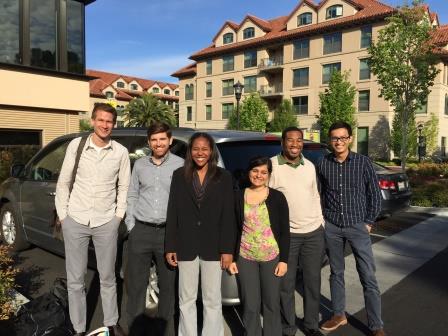An Inside Look at Detention Conditions for Confined Immigrants Awaiting Hearing
” . . . the realities of confinement are indisputably bleak, regardless of whether individuals are considered detainees or criminals.” —Nayha Arora (JD ’16) on the conditions immigrant detainees face similar to that of incarcerated convicted criminals.
Nayha shares the experience and her observations of a tour of the new privately-run Mesa Verde Detention Facility as part of her policy work in the Immigrants’ Rights Clinic.

This quarter in the Immigrants’ Rights Clinic, I have had the opportunity to both represent an individual client in her case and research policy issues that affect the immigrant community broadly. One of these issues is immigration detention. In March of this year, the Department of Homeland Security (DHS) began moving immigrant detainees from facilities in Sacramento and Yuba to the newly-opened Mesa Verde Detention Facility, a private detention center run by the GEO Group located in Bakersfield, California. Together with our clinic supervisor, my classmates and I drove roughly five hours from Palo Alto to Bakersfield to visit the new facility in mid-May.
Under the law, immigrants in removal proceedings are detained if they are considered flight risks or dangers to public safety. Detainees are not
criminals, however. I was interested to see whether this distinction influenced the conditions and operations of the detention facility.
We were greeted at Mesa Verde by the Warden, his assistant, and two officers. They gave us a tour of the facility, which feels and looks similar to some county jails. The grounds of Mesa Verde are surrounded by a barb wired fence. When detainees enter the facility, all their belongings are taken from them, and they are given a uniform. Detainees’ activities and schedules, from recreation to visitation, are all subject to facility approval and carefully monitored. Medical resources are limited, as well; the medical unit employs only one part-time physician, dentist, and psychiatrist for 400 people.
Personally, I was most struck by the silence in the hallways, communal spaces, and dormitories. Recreation areas and the library were vacant, and there was little chatter or interaction among individuals. The tour confirmed for me that the realities of confinement are indisputably bleak, regardless of whether individuals are considered detainees or criminals.
Immigration detention also makes it difficult for detainees to acquire and retain effective legal representation. Detention complicates the process of obtaining counsel in obvious ways: detainees have limited access to phones and contact information for attorneys, and they cannot freely communicate with friend and family networks to connect with counsel, either. These challenges are compounded because facilities like Mesa Verde are often located in remote areas far away from law firms and nonprofit organizations. If a detainee nonetheless manages to obtain representation, any attorney-client meetings are subject to (and often restricted by) the scheduling protocol and policies in place at the detention facility.
Individuals who do not acquire counsel must represent themselves. Immigration law is intricate and difficult to navigate without representation. Detainees who represent themselves contend with additional challenges, again, due to the nature of detention. Their knowledge is limited to what is supplied to them in the detention facility, and they do not receive any training on how to conduct legal research. Pro se materials in facilities like Mesa Verde are often limited in breadth and mostly written in English. Also, detainees cannot use the library whenever they wish; they must schedule their visit and abide by time limits. Finally, the computer program for legal research, which is also in English, sometimes is not regularly updated by the immigration authorities.
Today, Mesa Verde houses roughly 300 detainees at the cost of $100 per person each day. As the facility’s population grows, so will the importance of attorney access to detainees and adequate resources for pro se representation. Immigration advocates are communicating regularly with DHS and the Mesa Verde authorities to improve accessibility to and the resources available at the facility. I have appreciated the opportunity to take part in these efforts as a part of the IRC.
Detention and confinement present innumerable challenges in detainees’ day-to-day lives. As long as immigration detention is an accepted practice, however, I am hopeful that government, private prison companies, and immigration advocates can secure the highest standard of representation and treatment for immigrant detainees.
